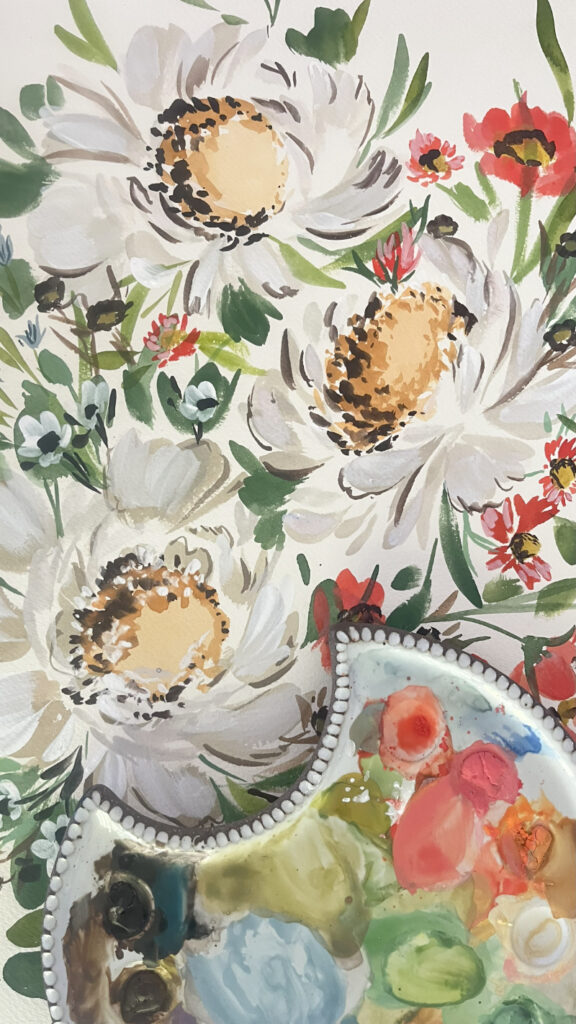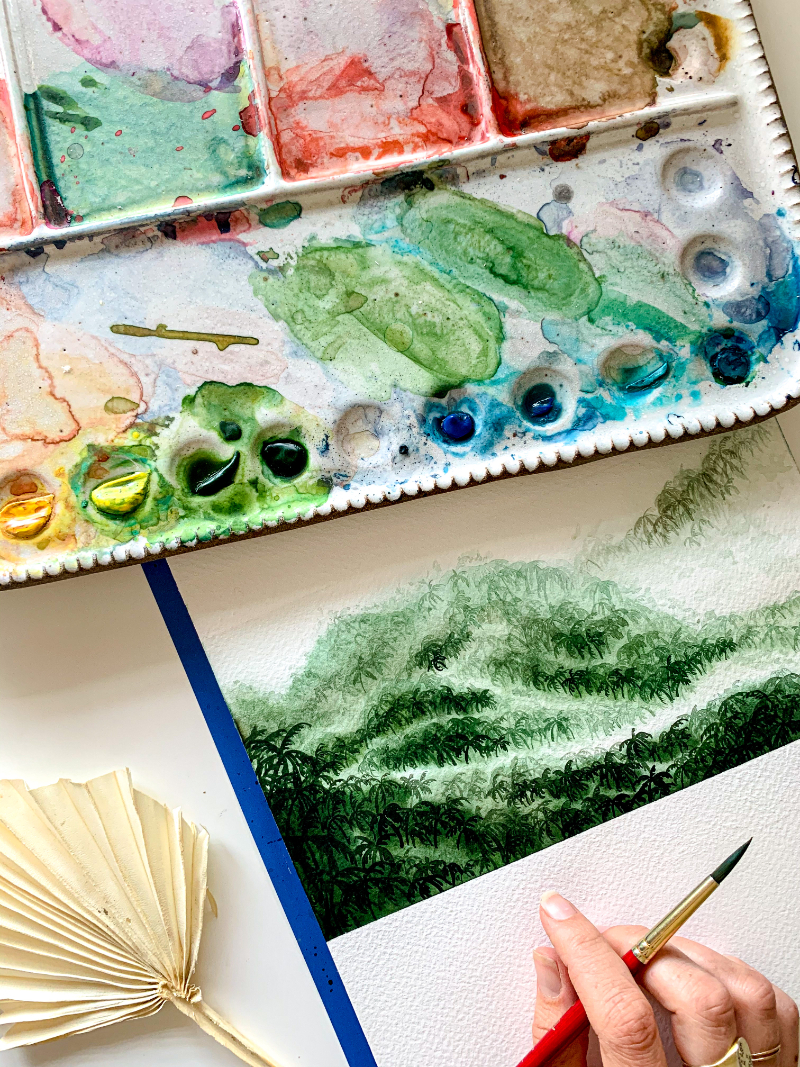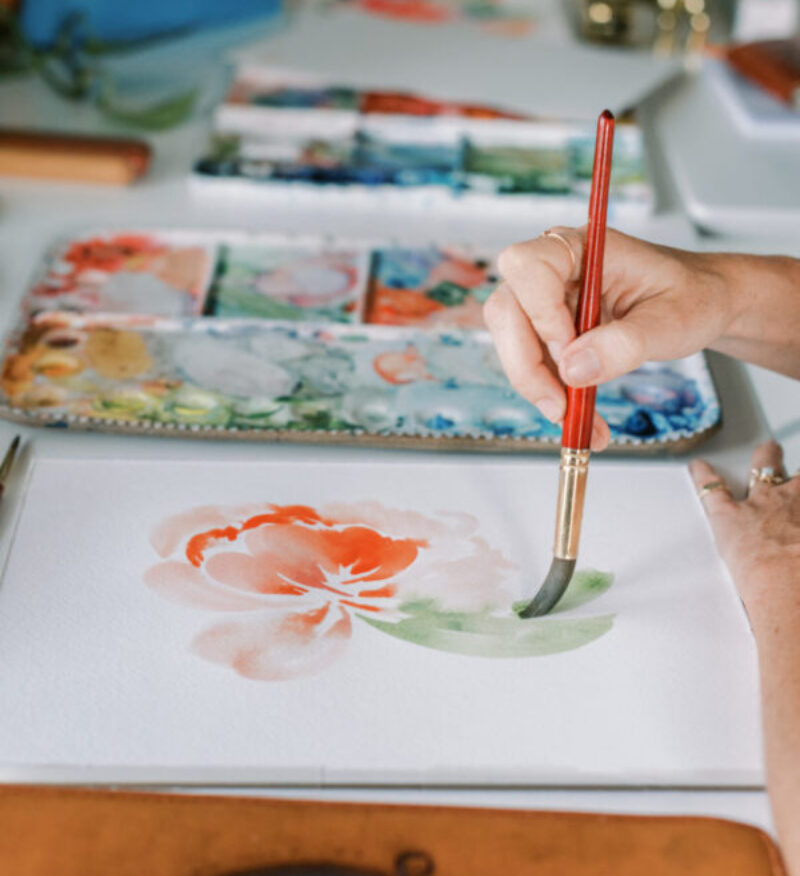When I first picked up a watercolor brush, I had a head full of doubts. I thought watercolor was only for “real” artists. You know, the ones who could sketch a perfect hand or paint something that looked like it belonged in a museum. If that sounds familiar, you’re not alone. Watercolor art has a reputation. Some of it’s earned, but a lot of it? Total myth. These watercolor myths don’t just mislead, they hold people back from even trying. And the thing is, watercolor can be so freeing once you stop worrying about doing it “right.”
Let’s break down a few of the biggest watercolor myths I hear all the time. If any of these are stuck in your head, they might just be the reason you haven’t felt that joy and flow in your creative process yet.

Myth #1: You Have to Be “Good at Drawing” to Use Watercolor
This one makes me want to gently (but firmly) shake people by the shoulders. You do not need to be a drawing expert to create beautiful watercolor art. In fact, some of the most expressive pieces come from loose shapes, abstract forms, and playful brushwork, not perfect lines.
When I started painting, I wasn’t drawing portraits or realistic landscapes. I was playing with color. I was exploring texture. (And yes, I was making a mess.) Watercolor is about expression, not perfection.
If you love to draw, great! That skill can support your painting. But if you don’t, watercolor still welcomes you with open arms. You can trace shapes, use stencils, or skip outlines altogether. You’re allowed to start where you are.
And if you're ready to build confidence with watercolor, my Everyday Watercolor book is a great place to start. It's designed specifically for beginners and walks you through the basics (like brush control, foundational strokes, and simple patterns) then gradually builds on those skills over 30 days. By the end, you're creating finished pieces and feeling more at home with your brush.
Myth #2: Watercolor Is Unforgiving and Too Hard to Control
Okay, I get why this one exists. Watercolor does have a mind of its own. It moves. It blends. It blooms. But that’s also what makes it magical.
Yes, it’s different from other paints. It’s more transparent, and the water plays a huge role in the outcome. But that doesn’t make it your enemy. In fact, once you stop fighting the water, you start flowing with it, literally and creatively.
With the right watercolor art materials (find my favorites here) and a little know-how, watercolor becomes way more manageable than people think. I always recommend beginners start by getting comfortable with water-to-paint ratios. Once you figure out how much water your brush holds, things start to click. (Trust me, learning that changed everything for me.)
If you’ve ever felt overwhelmed or like your creativity is just out of reach, you’re not alone. That’s exactly why I created The Art Within, a course designed to help you reconnect with your creative self, no matter your medium. It’s about shifting your mindset, letting go of perfection, and building a sustainable, joy-filled creative practice. Because it’s not just about technique, it’s about the heart behind your art.

Myth #3: You Need Fancy, Expensive Supplies to Get Started
Listen, I love art supplies as much as the next artist (probably more). I geek out over paper texture and get way too excited about brushes. But you do not need to spend hundreds of dollars to begin.
There’s a lot of noise out there about watercolor art materials. Some brands are amazing and worth the investment later on, but when you’re starting out, your focus should be on practice, not perfection.
What matters most is using the right type of watercolor paper (cold-press, is my personal favorite), getting a decent watercolor brush or two (round brushes in sizes 6 and size 16 are my go-to), and picking up a simple watercolor palette with a basic color range.
And just so you know, I’ve tested a lot of supplies over the years. My resources (like my Everyday Watercolor Companion Course includes a full supply list to take out the guesswork. You can also find my favorites here! I only recommend what I truly love and use myself.
Myth #4: You Should Know Your Style Right Away
Oh, friend. No, no, no. Your style isn’t something you decide before you begin. It’s something you find while you’re making a whole bunch of things. Some you love, some… not so much.
Style evolves with practice. It comes from following your curiosity, copying artists you admire (as studies, not for profit), and noticing what lights you up. I spent years trying different techniques, color palettes, and subjects before I started recognizing my voice in my work.
And it still shifts. That’s part of the fun.
If you’re stressing about not having a “signature look,” take a breath. You’re in the messy middle, which is actually a beautiful place to be. Give yourself permission to experiment. Paint what feels good. Try new things.
Myth #5: If It Doesn’t Look Like the Photo, It’s Wrong
I saved this one for last because it’s sneaky. Even when we know art isn’t supposed to be perfect, we still catch ourselves comparing our work to a reference photo and thinking, “Well, that’s not right.”
Here’s the truth: watercolor isn’t about duplicating reality. It’s about interpreting it. It’s about capturing a feeling or a moment or a mood. Your version doesn’t have to look like the photo. In fact, I’d argue it shouldn’t.
Watercolor thrives on looseness. On suggestion. On imagination. The magic is in the imperfection. The wonky leaves, the soft edges, the unpredictable washes. That’s where the soul of the painting lives.
When I teach beginners, I always say, “You’re not a printer.” You’re an artist. Your job isn’t to replicate. It’s to express.
If that shift in thinking excites you, I’ve got a bunch of projects in Everyday Watercolor Seashores and Everyday Watercolor Companion Course that are perfect for practicing this looser, more intuitive approach.

Let’s Bust These Watercolor Myths for Good
Watercolor myths keep so many people from even picking up a brush. But the truth? Watercolor is for everyone, not just the naturally talented, the professionally trained, or the perfectly prepared.
If you’ve believed any of these myths, I hope you feel a little lighter now. Like maybe the door to watercolor art just opened a bit wider.
And if you’re ready to step through that door, I’d love to be your guide. Start with my books if you want step-by-step structure. Or dive deeper into the creative journey with The Art Within, my online course that helps you find your voice, build your skills, and fall in love with the process.
Because watercolor doesn’t have to be intimidating. It just has to be yours.












+ show Comments
- Hide Comments
add a comment